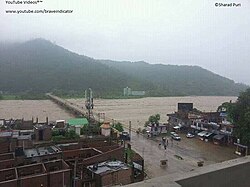| West Rapti Kuwano | |
|---|---|
 West Rapti river at Bhalubang | |
 | |
| Location | |
| Country | Nepal, India |
| Physical characteristics | |
| Source | |
| • location | Rapti Zone, Nepal south of border of Rukum District with Rolpa District |
| • coordinates | 28°28′33″N 82°52′44″E / 28.4757°N 82.8788°E |
| • elevation | 3,500 m (11,500 ft) |
| Mouth | |
• location | Ghaghara River |
• coordinates | 26°17′20″N 83°40′08″E / 26.289°N 83.669°E |
• elevation | 60 m (200 ft) |
| Basin size | 23,900 km2 (9,200 sq mi) |
| Discharge | |
| • average | 136 m3/s (4,800 cu ft/s) |
| Basin features | |
| River system | Ganges |
| Tributaries | |
| • left | Lungri Khola, Jhimruk Khola, Ami River, Rohini River |
| • right | Arun Khola, |
The West Rapti, also known as the Kuwano, is a river which drains Rapti Zone in Mid-Western Region, Nepal, then Awadh and Bhojpur-Purvanchal regions of Uttar Pradesh state, and finally India before joining the Ghaghara. It is a major left bank tributary of the Ganges, and is also known as the Karnali in Nepal.
The West Rapti is notable for janajati ethnic groups – Kham Magar among its highland sources and then Tharu in Inner Terai Deukhuri Valley, for its irrigation and hydroelectric potential, and for recurrent floods that led to its nickname "Gorakhpur's Sorrow".
Max depth 8.50
Min depth 10.7